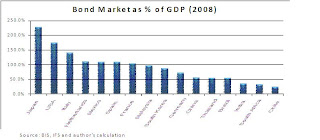In this context, the development of local currency bond markets, for both private and government debt, assume great significance. Further, a broadly developed domestic corporate bond market will mitigate the effects of global financial market shocks like the sub-prime mortgage crisis. It will also enable more efficient distortions management of the domestic currency in the global forex markets.
In a Vox article, Ismail Dalla and Heiko Hesse examined local currency bond markets in emerging economies and finds a rapidly growing market (doubling in size from $2.2 trillion in 2003 to $5.5 trillion at the end 2008), though slowed down by the current crisis. The bond markets have developed most rapidly in East Asia, which formed 55.4% of total outstanding emerging country local currency bonds by value (South Asia was just 8.4%). A few findings from the report
Compared to the East Asian economies, the corporate bond market in India is very narrow.


Though domestic institutional investors like pension funds, insurance companies, and mutual funds are amongst the largest investors in these bonds, pension assets as a percentage of GDP is among the lowest in India. Domestic institutional investors can play key roles in bond market development - their stable investment horizon and buy-and-hold behaviour can contribute to the financial stability of domestic financial markets; their maintaining their asset allocations during market downturns provide a buffer against volatile capital flows; existence of a domestic institutional investor base will attract foreign investors to domestic markets, as these investors can provide them with a put option if they wish to exit the market.

No comments:
Post a Comment